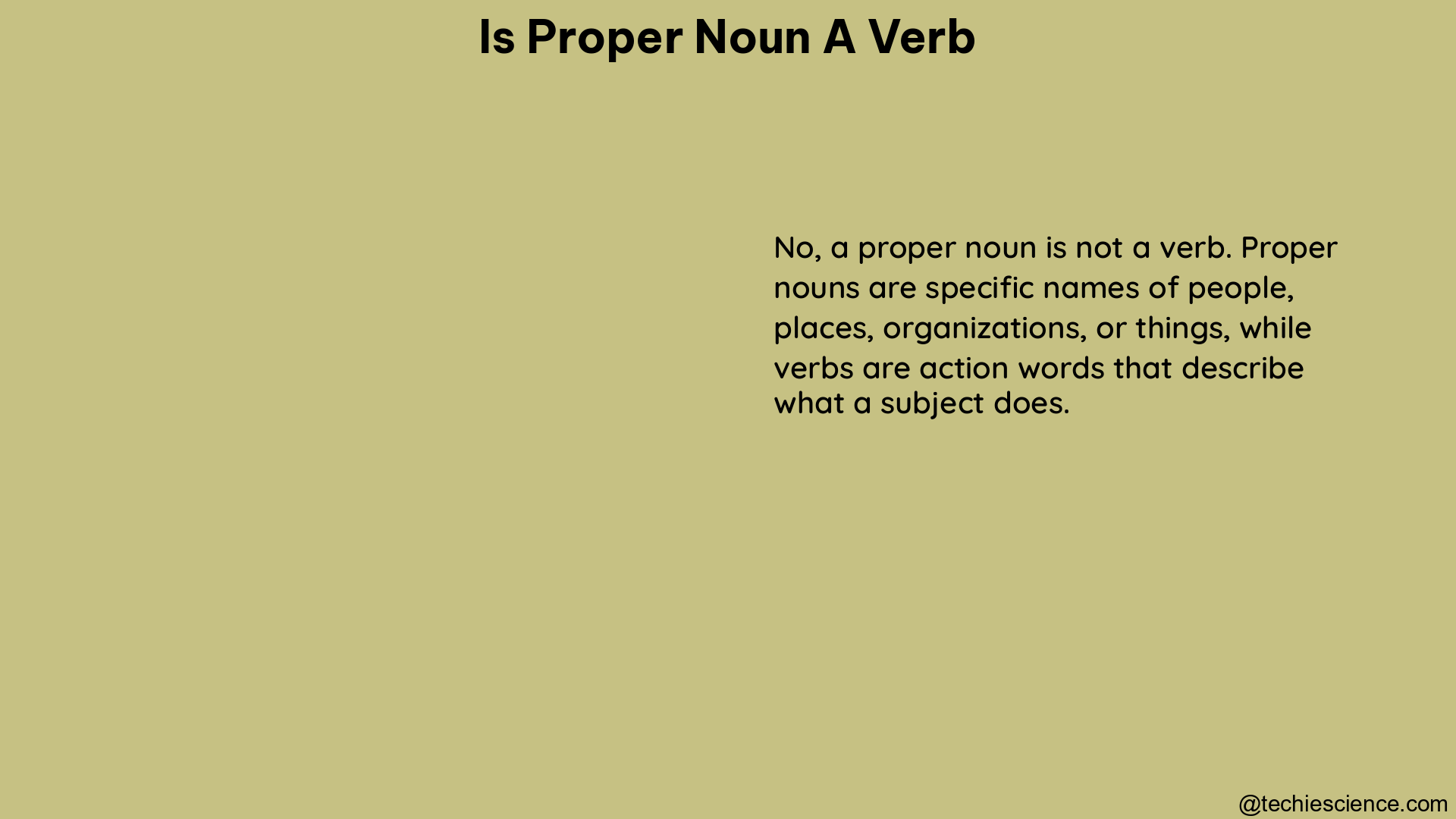No, a proper noun is not a verb. Proper nouns are specific names for people, places, or things, while verbs are words that express actions, events, or states of being. This article will delve into the distinct definitions, examples, and the process of converting proper nouns into verbs, providing a comprehensive understanding of the relationship between these two fundamental parts of speech.
Definition of Proper Nouns
A proper noun is a noun that serves as the name for a specific person, place, or thing. Proper nouns are always capitalized in English to distinguish them from common nouns, which are more general terms for types of people, places, or things.
Examples of Proper Nouns
- Personal Names: John, Sarah, Michael
- Place Names: New York, London, Tokyo
- Company Names: Google, Apple, Microsoft
- Book Titles: To Kill a Mockingbird, The Lord of the Rings, Pride and Prejudice
Definition of Verbs

Verbs are words that express actions, events, or states of being. They can be classified into various types, such as:
- Action Verbs: run, jump, write
- Linking Verbs: be, seem, appear
- Helping Verbs: will, would, have
Verbs play a crucial role in constructing sentences and conveying the dynamic nature of language.
Conversion of Proper Nouns to Verbs
While proper nouns are not inherently verbs, they can be converted into verbs through a process called “conversion” or “verbification.” This involves using a proper noun as a verb without changing its form. This process is often observed in the context of brand names or company names being used as verbs.
Examples of Proper Nouns Used as Verbs
- Xerox: a company name used as a verb (e.g., “I xeroxed the document.”)
- FedEx: a company name used as a verb (e.g., “I FedEx’d the package.”)
- Google: a company name used as a verb (e.g., “I googled the information.”)
- Photoshop: a software name used as a verb (e.g., “I photoshopped the image.”)
It’s important to note that while these proper nouns have been converted into verbs, they are not considered “proper verbs,” as this is not a recognized category in linguistics.
Grammatical Considerations
- Capitalization: Proper nouns are always capitalized, even when used as verbs, to maintain their distinctive status as specific names.
- Verb Conjugation: When proper nouns are used as verbs, they follow the standard verb conjugation rules, such as adding “-ed” for the past tense (e.g., “I xeroxed the document.”).
- Verb Tenses: Proper nouns used as verbs can be conjugated in various tenses, just like any other verb (e.g., “I will google the information,” “I have photoshopped the image.”).
- Verb Phrases: Proper nouns used as verbs can be combined with other verbs or adverbs to form verb phrases (e.g., “I quickly googled the information,” “She had already FedEx’d the package.”).
Linguistic Perspectives
From a linguistic perspective, the conversion of proper nouns into verbs is a phenomenon known as “verbification” or “denominalization.” This process is not limited to proper nouns and can also occur with common nouns, adjectives, and even adverbs.
Linguists have studied the reasons behind this conversion, which can include:
- Convenience: Using a well-known proper noun as a verb can be a concise and efficient way to convey a specific action or process.
- Branding: Companies may encourage the use of their brand names as verbs to increase brand recognition and association with a particular action or service.
- Linguistic Creativity: The conversion of proper nouns into verbs can be seen as a creative linguistic process that expands the expressive capabilities of language.
Conclusion
In summary, while proper nouns are not inherently verbs, they can be converted into verbs through a process called “verbification” or “denominalization.” This conversion does not make them “proper verbs,” as this is not a recognized category in linguistics. Proper nouns used as verbs follow standard verb conjugation rules and can be combined with other verbs or adverbs to form verb phrases. Understanding the distinction between proper nouns and verbs, as well as the process of converting proper nouns into verbs, is crucial for effective communication and language comprehension.
References
- Margie Holds Court. (2015, July 12). Proper Nouns Used as Verbs. Retrieved from https://margieholdscourt.com/blogs/blog/proper-nouns-used-as-verbs
- English Stack Exchange. (2019, March 31). Is there such a thing as a proper verb, like a proper noun? Retrieved from https://english.stackexchange.com/questions/492049/is-there-such-a-thing-as-a-proper-verb-like-a-proper-noun
- Scribbr. (2022, August 18). What Is a Proper Noun? | Definition & Examples. Retrieved from https://www.scribbr.com/nouns-and-pronouns/proper-nouns/
- Nordquist, R. (2019, July 3). What Is Verbification in Grammar? ThoughtCo. Retrieved from https://www.thoughtco.com/what-is-verbification-1692484
- Brinton, L. J., & Traugott, E. C. (2005). Lexicalization and Language Change. Cambridge University Press.
Hey! I am Arpita Bose Roy. My qualifications are M.A. in English with B. Ed. in both general education and special education. I have 2 years of experience as a “language analyst” at IIT Kharagpur and 4 years of experience as an “Academic Content Developer” at IIT Kharagpur. Currently, I am working as an academic writer at Lambdageeks.